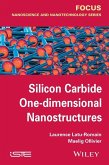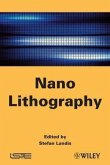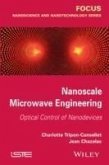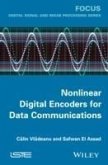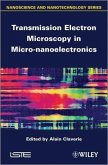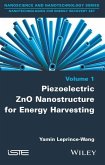Beyond-CMOS Nanodevices 2 (eBook, ePUB)
Redaktion: Balestra, Francis
139,99 €
139,99 €
inkl. MwSt.
Sofort per Download lieferbar

0 °P sammeln
139,99 €
Als Download kaufen

139,99 €
inkl. MwSt.
Sofort per Download lieferbar

0 °P sammeln
Jetzt verschenken
Alle Infos zum eBook verschenken
139,99 €
inkl. MwSt.
Sofort per Download lieferbar
Alle Infos zum eBook verschenken

0 °P sammeln
Beyond-CMOS Nanodevices 2 (eBook, ePUB)
Redaktion: Balestra, Francis
- Format: ePub
- Merkliste
- Auf die Merkliste
- Bewerten Bewerten
- Teilen
- Produkt teilen
- Produkterinnerung
- Produkterinnerung

Bitte loggen Sie sich zunächst in Ihr Kundenkonto ein oder registrieren Sie sich bei
bücher.de, um das eBook-Abo tolino select nutzen zu können.
Hier können Sie sich einloggen
Hier können Sie sich einloggen
Sie sind bereits eingeloggt. Klicken Sie auf 2. tolino select Abo, um fortzufahren.

Bitte loggen Sie sich zunächst in Ihr Kundenkonto ein oder registrieren Sie sich bei bücher.de, um das eBook-Abo tolino select nutzen zu können.
This book offers a comprehensive review of the state-of-the-art in innovative Beyond-CMOS nanodevices for developing novel functionalities, logic and memories dedicated to researchers, engineers and students. The book will particularly focus on the interest of nanostructures and nanodevices (nanowires, small slope switches, 2D layers, nanostructured materials, etc.) for advanced More than Moore (RF-nanosensors-energy harvesters, on-chip electronic cooling, etc.) and Beyond-CMOS logic and memories applications.
- Geräte: eReader
- mit Kopierschutz
- eBook Hilfe
- Größe: 5.18MB
Andere Kunden interessierten sich auch für
![Beyond-CMOS Nanodevices 1 (eBook, ePUB) Beyond-CMOS Nanodevices 1 (eBook, ePUB)]() Beyond-CMOS Nanodevices 1 (eBook, ePUB)168,99 €
Beyond-CMOS Nanodevices 1 (eBook, ePUB)168,99 €![Silicon Carbide One-dimensional Nanostructures (eBook, ePUB) Silicon Carbide One-dimensional Nanostructures (eBook, ePUB)]() Laurence Latu-RomainSilicon Carbide One-dimensional Nanostructures (eBook, ePUB)139,99 €
Laurence Latu-RomainSilicon Carbide One-dimensional Nanostructures (eBook, ePUB)139,99 €![Nano Lithography (eBook, ePUB) Nano Lithography (eBook, ePUB)]() Nano Lithography (eBook, ePUB)139,99 €
Nano Lithography (eBook, ePUB)139,99 €![Nanoscale Microwave Engineering (eBook, ePUB) Nanoscale Microwave Engineering (eBook, ePUB)]() Charlotte Tripon-CanselietNanoscale Microwave Engineering (eBook, ePUB)139,99 €
Charlotte Tripon-CanselietNanoscale Microwave Engineering (eBook, ePUB)139,99 €![Nonlinear Digital Encoders for Data Communications (eBook, ePUB) Nonlinear Digital Encoders for Data Communications (eBook, ePUB)]() Calin VladeanuNonlinear Digital Encoders for Data Communications (eBook, ePUB)139,99 €
Calin VladeanuNonlinear Digital Encoders for Data Communications (eBook, ePUB)139,99 €![Transmission Electron Microscopy in Micro-nanoelectronics (eBook, ePUB) Transmission Electron Microscopy in Micro-nanoelectronics (eBook, ePUB)]() Alain ClaverieTransmission Electron Microscopy in Micro-nanoelectronics (eBook, ePUB)140,99 €
Alain ClaverieTransmission Electron Microscopy in Micro-nanoelectronics (eBook, ePUB)140,99 €![Piezoelectric ZnO Nanostructure for Energy Harvesting, Volume 1 (eBook, ePUB) Piezoelectric ZnO Nanostructure for Energy Harvesting, Volume 1 (eBook, ePUB)]() Yamin Leprince-WangPiezoelectric ZnO Nanostructure for Energy Harvesting, Volume 1 (eBook, ePUB)139,99 €
Yamin Leprince-WangPiezoelectric ZnO Nanostructure for Energy Harvesting, Volume 1 (eBook, ePUB)139,99 €-
-
-
This book offers a comprehensive review of the state-of-the-art in innovative Beyond-CMOS nanodevices for developing novel functionalities, logic and memories dedicated to researchers, engineers and students. The book will particularly focus on the interest of nanostructures and nanodevices (nanowires, small slope switches, 2D layers, nanostructured materials, etc.) for advanced More than Moore (RF-nanosensors-energy harvesters, on-chip electronic cooling, etc.) and Beyond-CMOS logic and memories applications.
Dieser Download kann aus rechtlichen Gründen nur mit Rechnungsadresse in A, B, BG, CY, CZ, D, DK, EW, E, FIN, F, GR, HR, H, IRL, I, LT, L, LR, M, NL, PL, P, R, S, SLO, SK ausgeliefert werden.
Produktdetails
- Produktdetails
- Verlag: John Wiley & Sons
- Seitenzahl: 320
- Erscheinungstermin: 3. Juni 2014
- Englisch
- ISBN-13: 9781118985113
- Artikelnr.: 41008520
- Verlag: John Wiley & Sons
- Seitenzahl: 320
- Erscheinungstermin: 3. Juni 2014
- Englisch
- ISBN-13: 9781118985113
- Artikelnr.: 41008520
- Herstellerkennzeichnung Die Herstellerinformationen sind derzeit nicht verfügbar.
Francis Balestra received the M.S. and Ph.D. degrees in electronics from the Institut Polytechnique, Grenoble, France, in 1982 and 1985, respectively. F. Balestra has been Director of IMEP (Institute of Microelectronics, Electromagnetism and Photonics) and previously from LPCS for a total of 10 years. He is now Director of the Sinano Institute (22 members from 12 European countries) devoted to the coordination of the research activities of the European academic community in the nanoelectronic field. He has coordinated European, National and Regional projects. Within FP6 and FP7, he coordinated the Sinano and Nanosil Networks of Excellence (NoE) that have represented unprecedented collaborations in Europe in the field of nanoelectronics, and is presently coordinating a European NoE of the 7th Framework Programme dealing with the study of innovative nanostructures for adding functionalities to CMOS for future nanosystems. He is a member of the European Academy of Sciences, of the Advisory Committee of the Chinese Journal of Semiconductors and Chinese Physics B and received the Blondel Medal (French SEE) in 2001. He is also member of the European ENIAC Scientific Community Council and several ENIAC/AENEAS Working Groups. Francis Balestra has coauthored over 130 publications in international scientific journals, 240 communications at international conferences (more than 70 invited papers and review articles), and 20 books or chapters.
ACKNOWLEDGMENTS ix
GENERAL INTRODUCTION xi
Francis BALESTRA
INTRODUCTION TO VOLUME 2: SILICON NANOWIRE BIO-CHEMICAL SENSORS 1
Francis BALESTRA
CHAPTER 1. SMALL SLOPE SWITCHES 5
Adrian M. IONESCU and Francis BALESTRA, Kathy BOUCART, Giovanni SALVATORE
and Alexandru RUSU
1.1. Introduction 5
1.2. Tunnel FETs 6
1.3. Ferroelectric gate FET 14
1.4. Bibliography 21
CHAPTER 2. NANOWIRE DEVICES 25
Gérard GHIBAUDO, Sylvain BARRAUD, Mikaël CASSÉ, Xin Peng WANG, Guo Qiang
LO, Dim-Lee KWONG, Marco PALA and Zheng FANG
2.1. Introduction 25
2.2. NW for logic CMOS devices 26
2.2.1. NW fabrication and technology 26
2.2.2. Quantum simulation of NWs 37
2.2.3. Electrical characterization of NWs 49
2.3. Nano-CMOS ultimate memories 66
2.3.1. Overview of memory 66
2.3.2. NW application in the evolutive solution path 67
2.3.3. NW technology along the disruptive solution path 73
2.4. Conclusions 81
2.5. Acknowledgments 82
2.6. Bibliography 82
CHAPTER 3. GRAPHENE AND 2D LAYER DEVICES FOR MORE MOORE AND MORE-THAN-MOORE
APPLICATIONS 97
Max C. LEMME
3.1. Introduction 97
3.2. Graphene 98
3.2.1. Graphene fabrication 98
3.2.2. Macroscopic graphene field effect transistors 101
3.2.3. Graphene nanoribbon transistors 103
3.2.4. Bilayer graphene and substrate effects 105
3.2.5. RF transistors 106
3.2.6. Alternative graphene switches 107
3.3. 2D materials beyond graphene 108
3.4. Conclusions 109
3.5. Acknowledgments 110
3.6. Bibliography 110
CHAPTER 4. NANOELECTROMECHANICAL SWITCHES 117
Hervé FANET
4.1. Context 117
4.2. Nanorelay principles 118
4.2.1. The electrostatic actuation 119
4.2.2. The piezoelectrical actuation 120
4.2.3. The magnetic actuation 120
4.2.4. The thermal actuation 120
4.3. Electrostatic nanorelay modeling and optimization 121
4.3.1. Dynamic modeling 121
4.3.2. Quasi-static modeling 124
4.4. Technological challenges for NEMS computing 127
4.4.1. Low voltage operation 127
4.4.2. Reliability of contact technology 128
4.5. NEMS-based architectures 129
4.5.1. Conventional architectures 129
4.5.2. Adiabatic architectures 130
4.6. Conclusions 131
4.7. Bibliography 132
LIST OF AUTHORS 133
INDEX 135
GENERAL INTRODUCTION xi
Francis BALESTRA
INTRODUCTION TO VOLUME 2: SILICON NANOWIRE BIO-CHEMICAL SENSORS 1
Francis BALESTRA
CHAPTER 1. SMALL SLOPE SWITCHES 5
Adrian M. IONESCU and Francis BALESTRA, Kathy BOUCART, Giovanni SALVATORE
and Alexandru RUSU
1.1. Introduction 5
1.2. Tunnel FETs 6
1.3. Ferroelectric gate FET 14
1.4. Bibliography 21
CHAPTER 2. NANOWIRE DEVICES 25
Gérard GHIBAUDO, Sylvain BARRAUD, Mikaël CASSÉ, Xin Peng WANG, Guo Qiang
LO, Dim-Lee KWONG, Marco PALA and Zheng FANG
2.1. Introduction 25
2.2. NW for logic CMOS devices 26
2.2.1. NW fabrication and technology 26
2.2.2. Quantum simulation of NWs 37
2.2.3. Electrical characterization of NWs 49
2.3. Nano-CMOS ultimate memories 66
2.3.1. Overview of memory 66
2.3.2. NW application in the evolutive solution path 67
2.3.3. NW technology along the disruptive solution path 73
2.4. Conclusions 81
2.5. Acknowledgments 82
2.6. Bibliography 82
CHAPTER 3. GRAPHENE AND 2D LAYER DEVICES FOR MORE MOORE AND MORE-THAN-MOORE
APPLICATIONS 97
Max C. LEMME
3.1. Introduction 97
3.2. Graphene 98
3.2.1. Graphene fabrication 98
3.2.2. Macroscopic graphene field effect transistors 101
3.2.3. Graphene nanoribbon transistors 103
3.2.4. Bilayer graphene and substrate effects 105
3.2.5. RF transistors 106
3.2.6. Alternative graphene switches 107
3.3. 2D materials beyond graphene 108
3.4. Conclusions 109
3.5. Acknowledgments 110
3.6. Bibliography 110
CHAPTER 4. NANOELECTROMECHANICAL SWITCHES 117
Hervé FANET
4.1. Context 117
4.2. Nanorelay principles 118
4.2.1. The electrostatic actuation 119
4.2.2. The piezoelectrical actuation 120
4.2.3. The magnetic actuation 120
4.2.4. The thermal actuation 120
4.3. Electrostatic nanorelay modeling and optimization 121
4.3.1. Dynamic modeling 121
4.3.2. Quasi-static modeling 124
4.4. Technological challenges for NEMS computing 127
4.4.1. Low voltage operation 127
4.4.2. Reliability of contact technology 128
4.5. NEMS-based architectures 129
4.5.1. Conventional architectures 129
4.5.2. Adiabatic architectures 130
4.6. Conclusions 131
4.7. Bibliography 132
LIST OF AUTHORS 133
INDEX 135
ACKNOWLEDGMENTS ix
GENERAL INTRODUCTION xi
Francis BALESTRA
INTRODUCTION TO VOLUME 2: SILICON NANOWIRE BIO-CHEMICAL SENSORS 1
Francis BALESTRA
CHAPTER 1. SMALL SLOPE SWITCHES 5
Adrian M. IONESCU and Francis BALESTRA, Kathy BOUCART, Giovanni SALVATORE
and Alexandru RUSU
1.1. Introduction 5
1.2. Tunnel FETs 6
1.3. Ferroelectric gate FET 14
1.4. Bibliography 21
CHAPTER 2. NANOWIRE DEVICES 25
Gérard GHIBAUDO, Sylvain BARRAUD, Mikaël CASSÉ, Xin Peng WANG, Guo Qiang
LO, Dim-Lee KWONG, Marco PALA and Zheng FANG
2.1. Introduction 25
2.2. NW for logic CMOS devices 26
2.2.1. NW fabrication and technology 26
2.2.2. Quantum simulation of NWs 37
2.2.3. Electrical characterization of NWs 49
2.3. Nano-CMOS ultimate memories 66
2.3.1. Overview of memory 66
2.3.2. NW application in the evolutive solution path 67
2.3.3. NW technology along the disruptive solution path 73
2.4. Conclusions 81
2.5. Acknowledgments 82
2.6. Bibliography 82
CHAPTER 3. GRAPHENE AND 2D LAYER DEVICES FOR MORE MOORE AND MORE-THAN-MOORE
APPLICATIONS 97
Max C. LEMME
3.1. Introduction 97
3.2. Graphene 98
3.2.1. Graphene fabrication 98
3.2.2. Macroscopic graphene field effect transistors 101
3.2.3. Graphene nanoribbon transistors 103
3.2.4. Bilayer graphene and substrate effects 105
3.2.5. RF transistors 106
3.2.6. Alternative graphene switches 107
3.3. 2D materials beyond graphene 108
3.4. Conclusions 109
3.5. Acknowledgments 110
3.6. Bibliography 110
CHAPTER 4. NANOELECTROMECHANICAL SWITCHES 117
Hervé FANET
4.1. Context 117
4.2. Nanorelay principles 118
4.2.1. The electrostatic actuation 119
4.2.2. The piezoelectrical actuation 120
4.2.3. The magnetic actuation 120
4.2.4. The thermal actuation 120
4.3. Electrostatic nanorelay modeling and optimization 121
4.3.1. Dynamic modeling 121
4.3.2. Quasi-static modeling 124
4.4. Technological challenges for NEMS computing 127
4.4.1. Low voltage operation 127
4.4.2. Reliability of contact technology 128
4.5. NEMS-based architectures 129
4.5.1. Conventional architectures 129
4.5.2. Adiabatic architectures 130
4.6. Conclusions 131
4.7. Bibliography 132
LIST OF AUTHORS 133
INDEX 135
GENERAL INTRODUCTION xi
Francis BALESTRA
INTRODUCTION TO VOLUME 2: SILICON NANOWIRE BIO-CHEMICAL SENSORS 1
Francis BALESTRA
CHAPTER 1. SMALL SLOPE SWITCHES 5
Adrian M. IONESCU and Francis BALESTRA, Kathy BOUCART, Giovanni SALVATORE
and Alexandru RUSU
1.1. Introduction 5
1.2. Tunnel FETs 6
1.3. Ferroelectric gate FET 14
1.4. Bibliography 21
CHAPTER 2. NANOWIRE DEVICES 25
Gérard GHIBAUDO, Sylvain BARRAUD, Mikaël CASSÉ, Xin Peng WANG, Guo Qiang
LO, Dim-Lee KWONG, Marco PALA and Zheng FANG
2.1. Introduction 25
2.2. NW for logic CMOS devices 26
2.2.1. NW fabrication and technology 26
2.2.2. Quantum simulation of NWs 37
2.2.3. Electrical characterization of NWs 49
2.3. Nano-CMOS ultimate memories 66
2.3.1. Overview of memory 66
2.3.2. NW application in the evolutive solution path 67
2.3.3. NW technology along the disruptive solution path 73
2.4. Conclusions 81
2.5. Acknowledgments 82
2.6. Bibliography 82
CHAPTER 3. GRAPHENE AND 2D LAYER DEVICES FOR MORE MOORE AND MORE-THAN-MOORE
APPLICATIONS 97
Max C. LEMME
3.1. Introduction 97
3.2. Graphene 98
3.2.1. Graphene fabrication 98
3.2.2. Macroscopic graphene field effect transistors 101
3.2.3. Graphene nanoribbon transistors 103
3.2.4. Bilayer graphene and substrate effects 105
3.2.5. RF transistors 106
3.2.6. Alternative graphene switches 107
3.3. 2D materials beyond graphene 108
3.4. Conclusions 109
3.5. Acknowledgments 110
3.6. Bibliography 110
CHAPTER 4. NANOELECTROMECHANICAL SWITCHES 117
Hervé FANET
4.1. Context 117
4.2. Nanorelay principles 118
4.2.1. The electrostatic actuation 119
4.2.2. The piezoelectrical actuation 120
4.2.3. The magnetic actuation 120
4.2.4. The thermal actuation 120
4.3. Electrostatic nanorelay modeling and optimization 121
4.3.1. Dynamic modeling 121
4.3.2. Quasi-static modeling 124
4.4. Technological challenges for NEMS computing 127
4.4.1. Low voltage operation 127
4.4.2. Reliability of contact technology 128
4.5. NEMS-based architectures 129
4.5.1. Conventional architectures 129
4.5.2. Adiabatic architectures 130
4.6. Conclusions 131
4.7. Bibliography 132
LIST OF AUTHORS 133
INDEX 135


